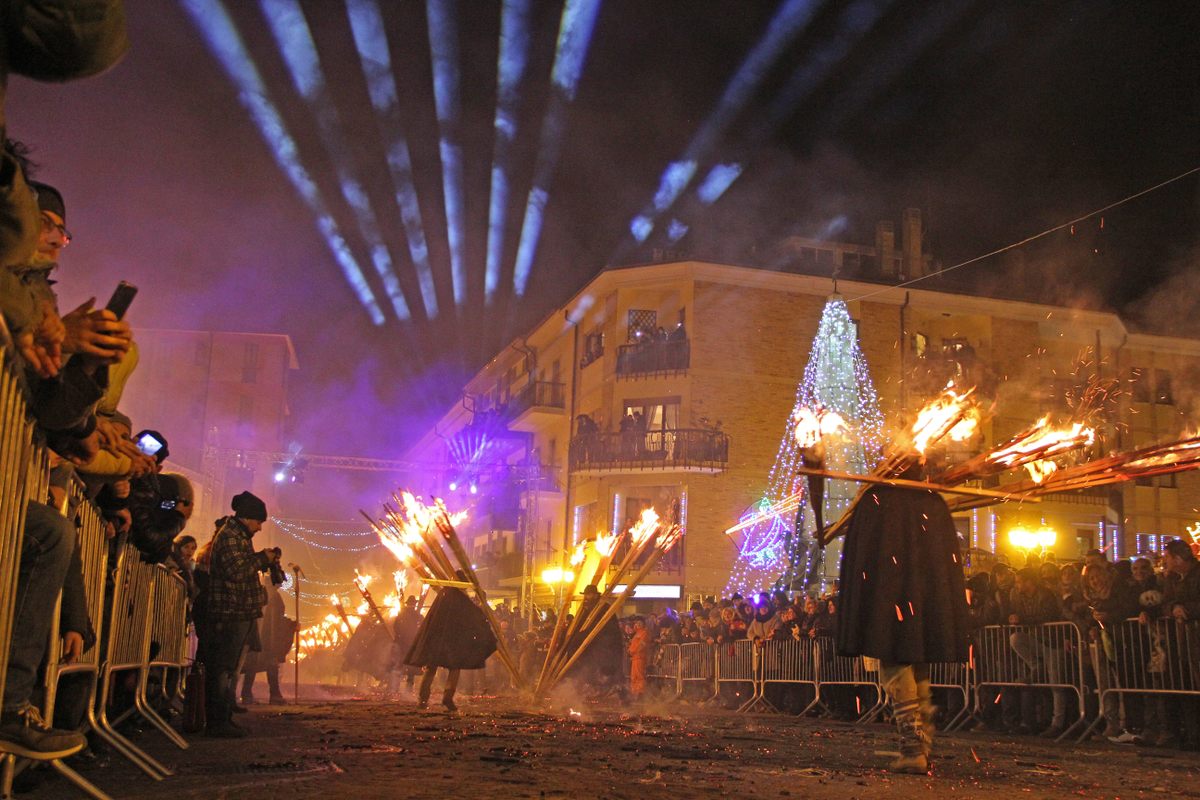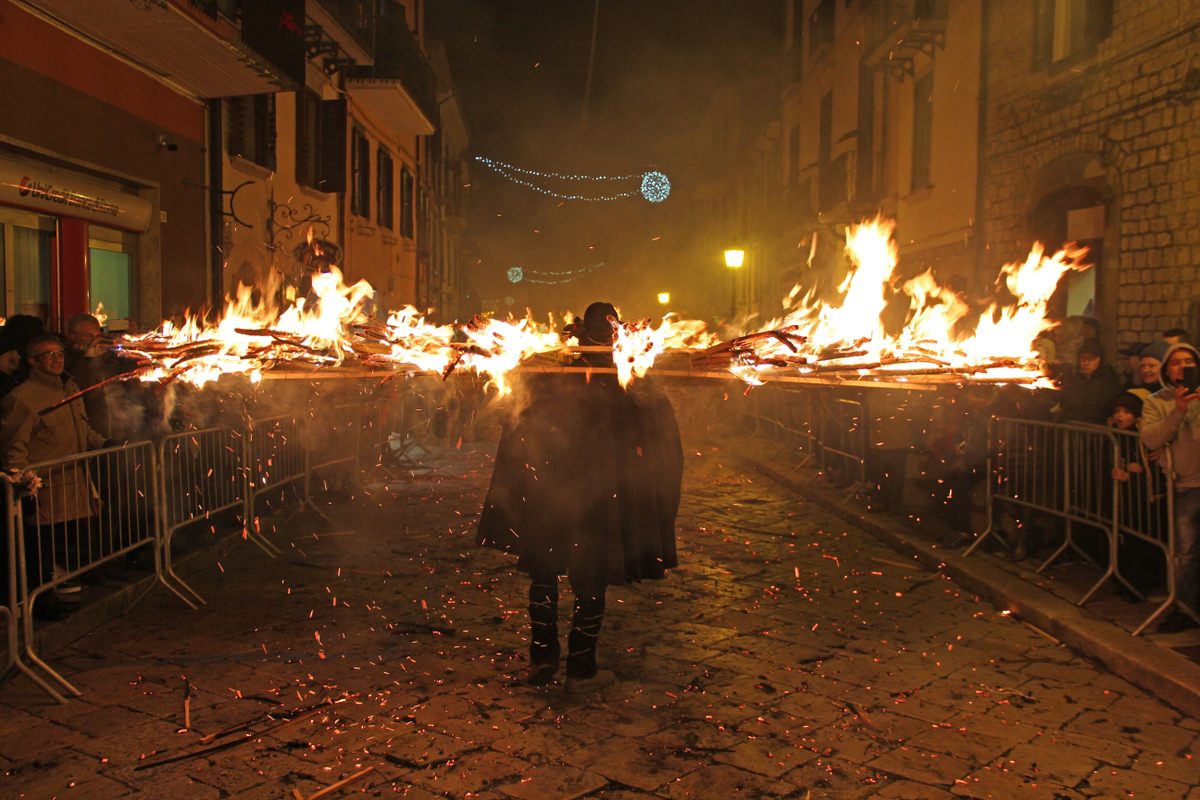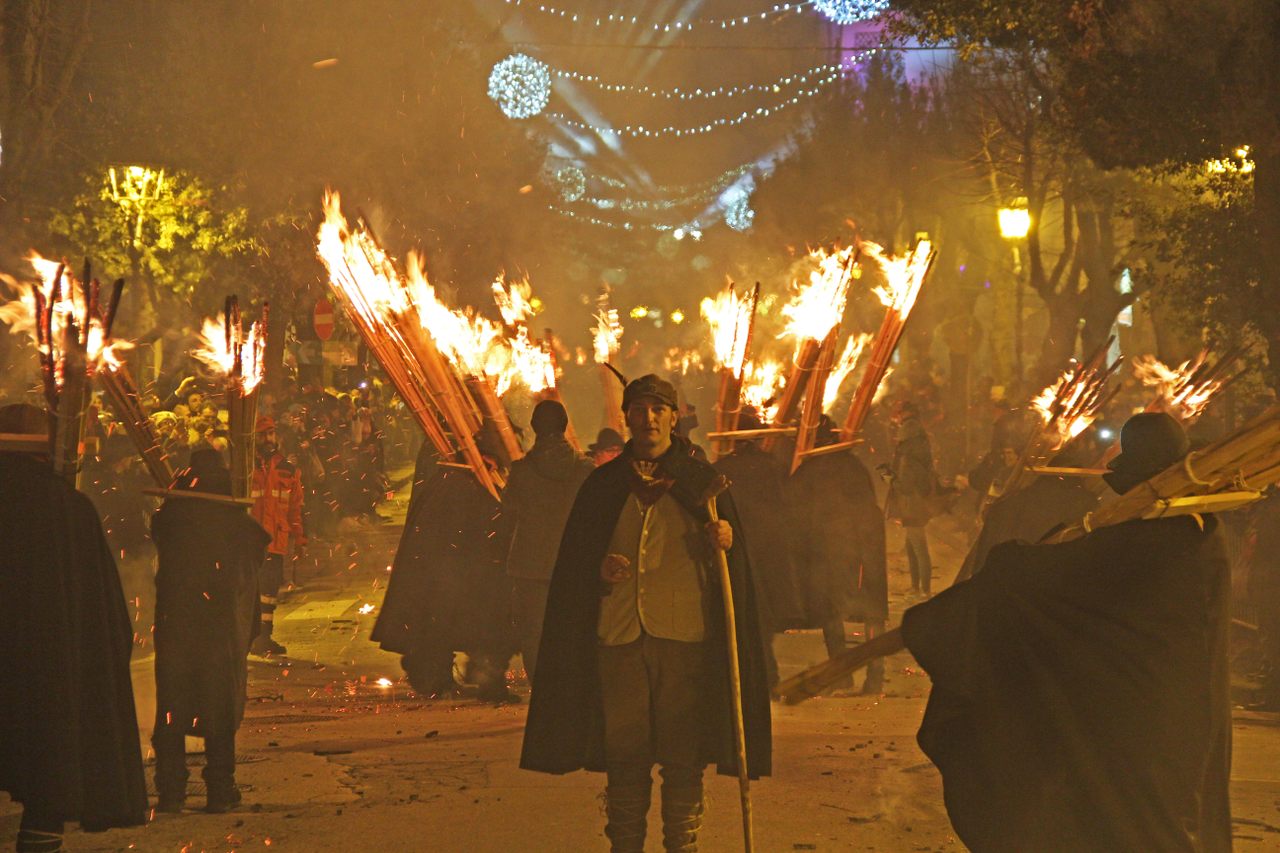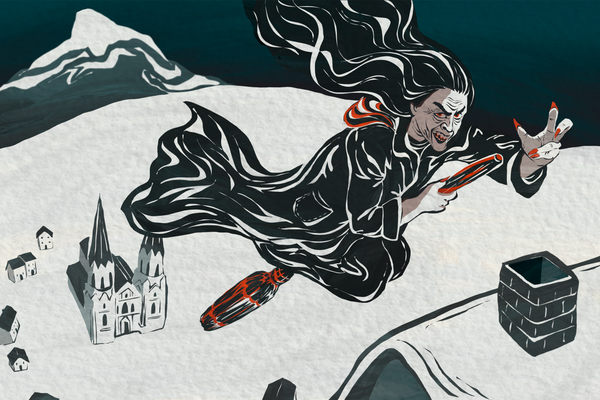The Italian Town That Welcomes Winter With a Procession of Fire
Every December, thousands of torches transform Agnone into the fire capital of the world.
You hear them before you see them. It’s a distinct crackling sound, like hundreds of dry leaves being stepped on at once. Then they emerge from the dark, wreathed in ripping fire that billows behind them like a flaming phoenix’s tail, streaking a trail of warmth in the chilly December air. A procession of hundreds of torch bearers make their way through the town’s narrow center in a ritual that has been maintained for hundreds—perhaps even thousands—of years. From above, the image is of a glowing primordial serpent weaving its way through ancient stone streets.
This is the Ndocciata, a fire ritual believed to be among the largest in the world that takes place every December in Agnone, a small hilltop town in the mountainous Italian region of Molise. Historically held on Christmas Eve, it also takes place on the first and second Saturday of December, a bright glimmer during the darkest month of the year. It is here, in a town with a population under 5,000, that hundreds of people carry 10-foot-tall torches, bearing anywhere between one and 26 fires. It’s a symbolic ritual to rid themselves of evil, lay the groundwork for an auspicious year, and welcome the days getting longer again.
And now, more towns in Italy are joining together to combine their various, unique fire rituals in an enormous blaze, in an attempt to solidify Agnone as the world’s capital of fire.

The ritual’s definitive origins have been lost to the smoky haze of time, but the central element of worshiping fire during the darkest time of year has ancient, pagan roots. “Celebrating the solstices was common to a lot of peoples in Europe and beyond, especially agricultural societies. And using fire and light is a common feature, because the winter solstice marks the darkest point in the year, from which the days get longer again,” explains Kathryn Lomas, an honorary research fellow in classics and ancient history at the University of Durham.
She references how the ancient Romans celebrated the winter festival of Saturnalia, an intricate ceremony often described as a festival of light and renewal. Ndocciata may not be a direct descendant of this ancient festival, but it similarly began at the beginning of December and spanned the winter solstice, underscoring the importance of fire in pagan societies.
Although the ancient Romans held dominion over Italy for close to a millennium, there was another ancient Italic people who inhabited present-day Molise and Abruzzo: the Samnites. A warrior tribe that existed between the fourth and first centuries BC, they also shared a close tie with the sun and fire, used for survival, communication, and symbolism. Despite the few surviving documents from this period, “we can undoubtedly affirm that the lighting of fires to greet the sun was a common heritage of all peoples of ancient Italy,” says Nicola Mastonardi, a historian, journalist, and novelist from Agnone. He added that it’s likely the Samnites also used fire to purify the earth.

While the Ndocciata may be a faint echo of these ancient pagan festivals, it has undoubtedly been shaped over the millenia by intervening historical events, such as the rise of Christianity. The ritual that we know today can be traced back to at least 1870, the first year it was officially documented, when it was predominantly used by farmers to bless their harvests and ward off evil (including witches, who were considered to be a very real threat in the 19th century).
The procession was also used to light the way for farmers living in the countryside to attend the midnight Christmas Eve mass in town. And it helped predict the incoming year’s fortunes: If the borea, the northern wind, was blowing during the burning of the torches, it was expected to be an auspicious year, according to Domenico Meo, a local historian who has helped organize the ritual for 20 years. The Ndocciata was formalized in 1932 with a competition for the most beautifully constructed torches. Today, the ritual is no longer focused on competition, though it has continued to grow and expand ever since.
For over 100 years, the Ndocciata was exclusively celebrated on Christmas Eve. Then in 1996, locals took the tradition to Rome on December 8 for Pope John Paul II’s 50th-anniversary of priesthood. The event, in which 1,200 torches burned brightly at the center of Christianity, was televised across Italy and in countries such as the United States, Canada, and Australia, according to Meo. It quickly garnered international attention and propelled the town to hold a second, much larger Ndocciata in 2000 on December 8.
More recently, it’s now held on the second Saturday of the month, drawing upwards of 20,000 visitors while 600 locals carry more than 1,000 torches. The historic Ndocciata is still held on Christmas Eve as well, though it’s much smaller and is a special moment shared only between locals.

Thousands of torches are assembled each year in preparation for the Ndocciata—but that doesn’t mean that entire forests are knocked down for the ritual. Torches are constructed out of white fir trees that are sick, dying, or were felled during winter storms. These are identified and marked by the National Forestry Corp in the spring, collected and dried in the summer, and assembled into 10-foot-tall conical torches in the fall. Dried branches of the Ginestra flower, which burn easily and brightly, are sandwiched between white fir logs. When lit, it produces a loud popping sound, a noise once believed to frighten off witches.
The procession begins in the town’s center when the bells of Agnone’s main church toll at 6 p.m. The first to appear are the figuranti, a group of women, very young children, and the elderly, who carry chickens, rabbits, and lambs in a physical manifestation of a manger scene. Then come the children, usually accompanied by their parents, who carry a single ndoccia, meaning “torch” in the local dialect. “This is one of the most fundamental aspects, because the tradition carries on when all ages participate, from the youngest to the oldest,” explains Meo. “There is almost certainly a future for this ritual because of this.”

The procession continues with torch bearers carrying more and more torches, alway in even numbers, all the way up to 26 fires. For those who carry multiple, torches are assembled into the shape of a fan to create a structure that rests upon their shoulders, so that the fires flow behind their necks. These heavy and often cumbersome structures can be carried on their own or by two men at once to share the brunt of their weight.
The procession closes with a showstopper: a torch bearer carrying 26 flaming fires weighing over 300 pounds, a feat that is not only a matter of strength, but also one of balance. These hundreds of torch bearers weave their way through Agnone’s center to reach the Falò della Fraternanza, a massive bonfire in which their torches are discarded in the ultimate display honoring the element as a purification vessel.
Now, the Ndocciata is getting even bigger. Quite a few towns in Italy have been celebrating December with fire rituals for hundreds of years, but always separately. Since 2022, they’ve joined forces in a single event: the Ritual Fire Festival. This conjoined Ndocciata was the brainchild of Meo and Daniele Saia, Agnone’s mayor, and takes place in Agnone on the first Saturday of December.
In 2023, 15 towns across the regions of Molise, Puglia, Abruzzo, and Tuscany convened in Agnone, a major increase from the five Molise towns that participated the previous year. “In almost every town, there are still some small fire rituals, but the ones that come to Agnone are the only ones who are still preserving their rituals on a larger scale,” notes Meo, who estimates that more than 600 people participated in this year’s ritual, and over 6,000 people attended.

“[We want to] breathe life back into these small towns that have lost their fire traditions to be able to pass them down to future generations,” explains Saia. “We don’t want to lose this cultural intangible heritage that has been preserved by generations. We want to maintain this life.” In addition to having fire rituals every Saturday leading up to Christmas Eve, the larger hope is to eventually accumulate more towns—not only in Italy, but across the world—to come to Agnone for the festival. By making the Ndocciata an international event, explains Saia, Agnone hopes to gain UNESCO Intangible Cultural Heritage status and make Agnone the world’s capital of fire
For now, however, Saia and Meo are content with what they’ve accomplished and view the mere existence of this new festival as an emotional milestone. “It’s beautiful, because you can see different expressions of the ritual,” says Meo. “Everyone has their own material—some use sugar canes, others chestnut trees—and everyone has their own kind of torch. It’s very important from a symbolic point of view.”

Oratino, a town in Molise, for example, doesn’t carry multiple torches like Agnone, but rather a massive one that’s 26 feet tall and three feet in diameter, and carried on the shoulders of 40 men. There are some towns who sing while they carry their torches horizontally, instead of vertically, or others who carry a whole trunk frayed slightly at the tip where it’s lit like a massive, flaming artichoke.
It’s the very celebration of this diversity that makes the Ritual Fire Festival so important. For Saia, it bolsters the need to preserve and celebrate traditions, and validates the cultural identity of the Ndocciata for the people of Agnone. “It’s an emotional experience tied to tradition. Aside from the spectacle, it’s an emotional intensity anchored to the history of our town and ancestors,” he says. “Every year, it’s like reliving it for the first time.”













Follow us on Twitter to get the latest on the world's hidden wonders.
Like us on Facebook to get the latest on the world's hidden wonders.
Follow us on Twitter Like us on Facebook